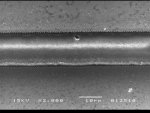Researchers at Purdue University’s Center for Laser-Based manufacturing are developing a new manufacturing process to make thin film solar cells more affordable and efficient.
Involving the use of an ultrafast pulsing laser, the process addresses two major challenges of more widespread solar panel uptake – manufacturing costs and sunlight conversion efficiency.
A solar cell consists of microchannels that are interconnected to other cells in order to assemble an array. Usual scribing methods to make these connections use a stylus, which can be comparatively slow and expensive. Additionally, the mechanical method results in imperfections that reduce a solar cell’s conversion efficiency performance; particularly in thin film solar panels.
Thin film solar is emerging as a popular choice given their cost and flexibility, but conversion efficiency rates remain lower than more traditional silicon based solar panels.
According to Purdue’s Professor Yung Shin, while the possibility of laser scribing has seen extensive research in the past, up until now controlling the lasers in a precise manner hasn’t been possible. Professor Shin and his team have discovered that an ultrashort pulse laser can accurately produce microchannels with precise depths, 10 to 20 nanometers, and sharp boundaries.
“Ultrashort” isn’t an exaggeration – the pulses from the laser last only a quadrillionths of a second. The rapid pulsing means heat damage to the sensitive thin film is avoided and material is removed in a process called cold ablation. The work can also be performed at very high speed – meters of surface area per second; which is also not possible with a mechanical scribe.
The researchers plan to establish the scientific basis for the laser-ablation technique over the next couple of years. Their work has been funded by a $425,000 grant from the National Science Foundation. The project is led by Professor Shin and Gary Cheng, an associate professor of industrial engineering.
Source/Image Source












































